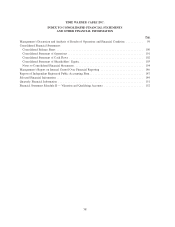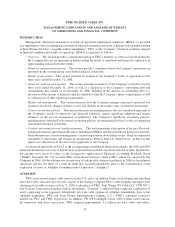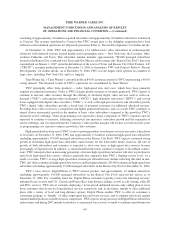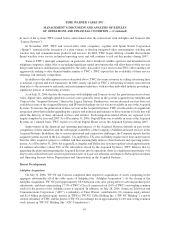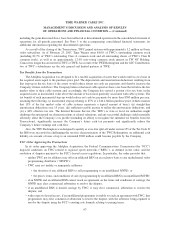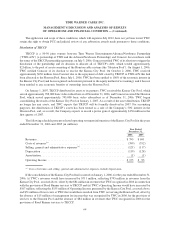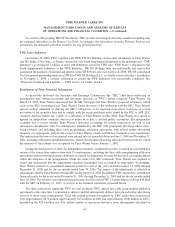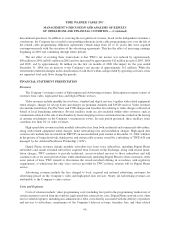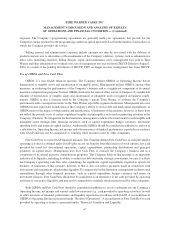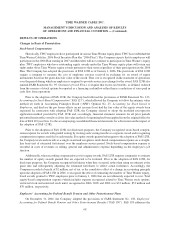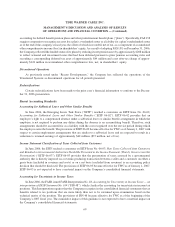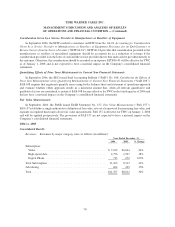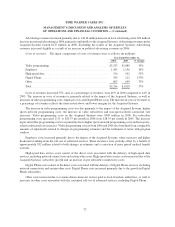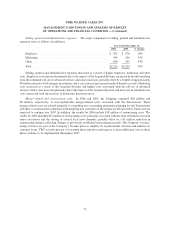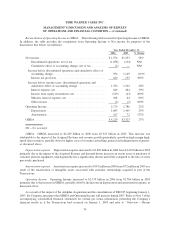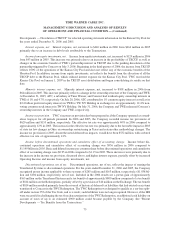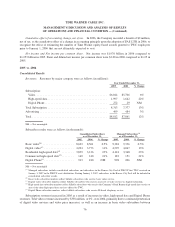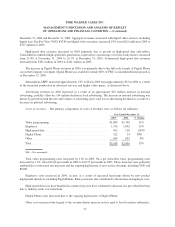Time Warner Cable 2006 Annual Report Download - page 72
Download and view the complete annual report
Please find page 72 of the 2006 Time Warner Cable annual report below. You can navigate through the pages in the report by either clicking on the pages listed below, or by using the keyword search tool below to find specific information within the annual report.expenses. The Company’s programming agreements are generally multi-year agreements that provide for the
Company to make payments to the programming vendors at agreed upon rates based on the number of subscribers to
which the Company provides the service.
Selling, general and administrative expenses include amounts not directly associated with the delivery of
products and services to subscribers or the maintenance of the Company’s delivery systems, such as administrative
labor costs, marketing expenses, billing charges, repair and maintenance costs, management fees paid to Time
Warner and other administrative overhead costs, net of management fees received from TKCCP. Effective August 1,
2006, as a result of the pending dissolution of TKCCP, TWC no longer receives management fees from TKCCP.
Use of OIBDA and Free Cash Flow
OIBDA is a non-GAAP financial measure. The Company defines OIBDA as Operating Income before
depreciation of tangible assets and amortization of intangible assets. Management utilizes OIBDA, among other
measures, in evaluating the performance of the Company’s business and as a significant component of its annual
incentive compensation programs because OIBDA eliminates the uneven effect across its business of considerable
amounts of depreciation of tangible assets and amortization of intangible assets recognized in business combi-
nations. OIBDA is also a measure used by the Company’s parent, Time Warner, to evaluate the Company’s
performance and is an important metric in the Time Warner reportable segment disclosures. Management also uses
OIBDA because it provides an indication of the Company’s ability to service debt and fund capital expenditures, as
OIBDA removes the impact of depreciation and amortization. A limitation of this measure, however, is that it does
not reflect the periodic costs of certain capitalized tangible and intangible assets used in generating revenues in the
Company’s business. To compensate for this limitation, management evaluates the investments in such tangible and
intangible assets through other financial measures, such as capital expenditure budget variances, investment
spending levels and return on capital analysis. Additionally, OIBDA should be considered in addition to, and not as
a substitute for, Operating Income, net income and other measures of financial performance reported in accordance
with GAAP and may not be comparable to similarly titled measures used by other companies.
Free Cash Flow is a non-GAAP financial measure. The Company defines Free Cash Flow as cash provided by
operating activities (as defined under GAAP) plus excess tax benefits from the exercise of stock options, less cash
provided by (used by) discontinued operations, capital expenditures, partnership distributions and principal
payments on capital leases. Management uses Free Cash Flow to evaluate the Company’s business and as a
component of its annual incentive compensation programs. The Company believes this measure is an important
indicator of its liquidity, including its ability to reduce net debt and make strategic investments, because it reflects
the Company’s operating cash flow after considering the significant capital expenditures required to operate its
business. A limitation of this measure, however, is that it does not reflect payments made in connection with
investments and acquisitions, which reduce liquidity. To compensate for this limitation, management evaluates such
expenditures through other financial measures, such as capital expenditure budget variances and return on
investment analyses. Free Cash Flow should not be considered as an alternative to net cash provided by operating
activities as a measure of liquidity, and may not be comparable to similarly titled measures used by other companies.
Both OIBDA and Free Cash Flow should be considered in addition to, not as a substitute for, the Company’s
Operating Income, net income and various cash flow measures (e.g., cash provided by operating activities), as well
as other measures of financial performance and liquidity reported in accordance with GAAP. A reconciliation of
OIBDA to Operating Income is presented under “Results of Operations.” A reconciliation of Free Cash Flow to cash
provided by operating activities is presented under “Financial Condition and Liquidity.”
67
TIME WARNER CABLE INC.
MANAGEMENT’S DISCUSSION AND ANALYSIS OF RESULTS
OF OPERATIONS AND FINANCIAL CONDITION — (Continued)



